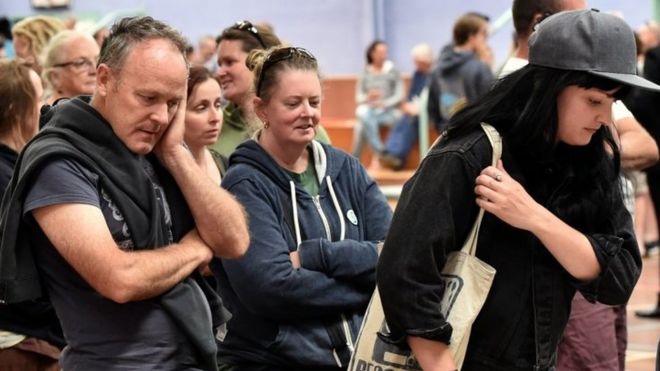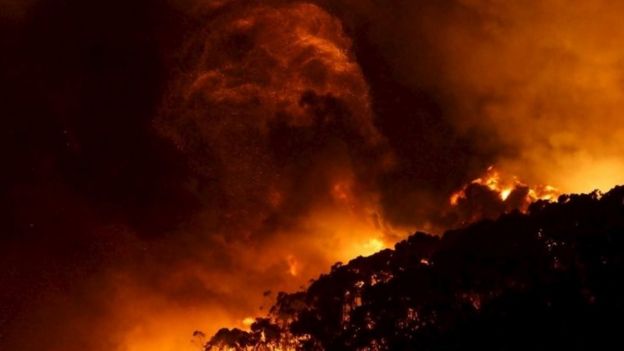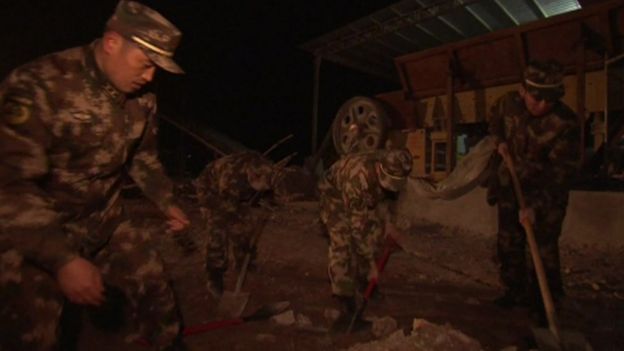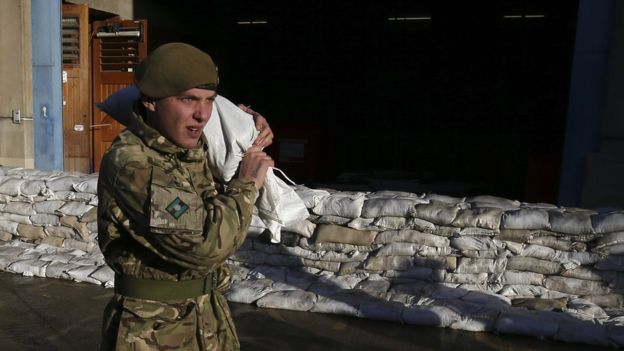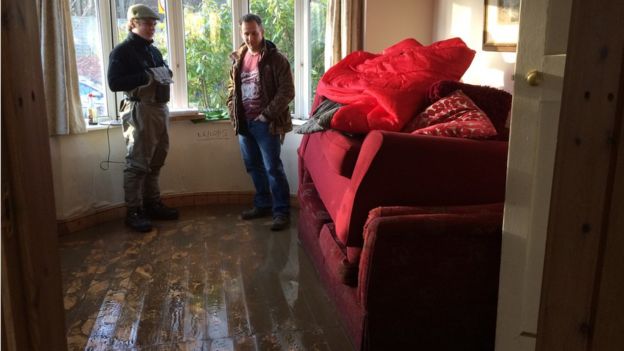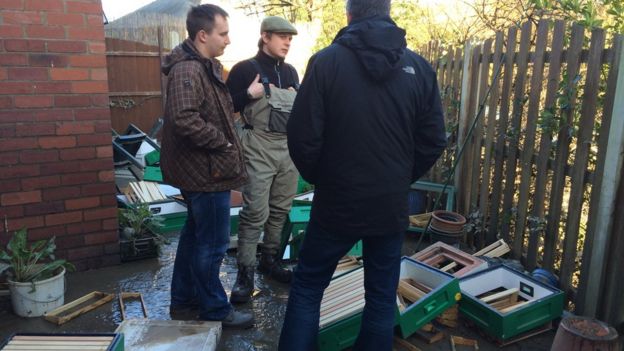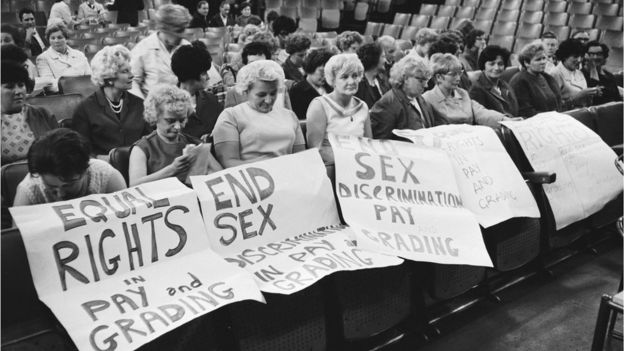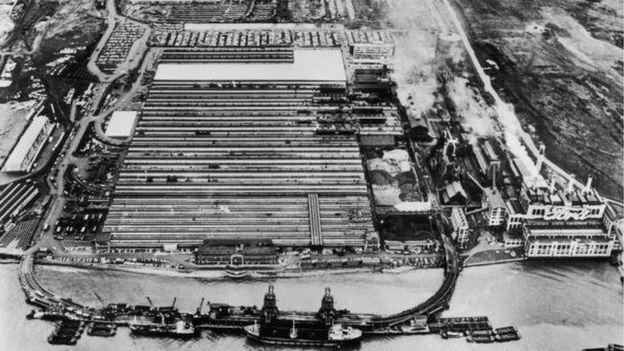25 DEC
Northern Afghanistan hit by 6.3-magnitude earthquake
A powerful 6.3-magnitude earthquake has struck northern Afghanistan, with tremors felt as far away as India.
According to the US Geological Survey, the quake's epicentre was in the northern province of Badakhshan, close to the Pakistani and Tajik borders.
It is not clear if there were any casualties in the area itself, but at least 17 people were injured in the Pakistani city of Peshawar.
Hundreds were killed by a quake in the same area on 26 October.
Residents in the Afghan capital, Kabul, and the Pakistani capital, Islamabad, were reported to have run into the streets after feeling the impact of the quake.
In Peshawar some old homes and walls collapsed, Hamid Nawaz, the head of Pakistan's disaster management authority, told AP.
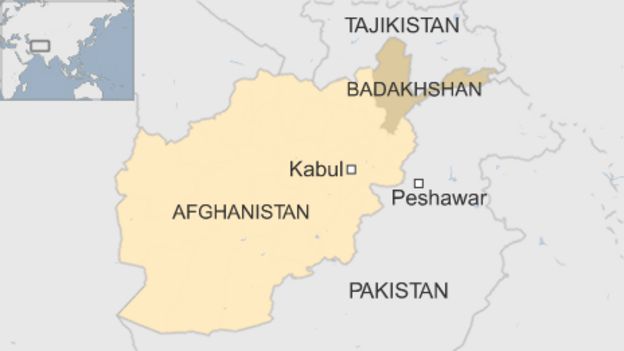
The region has a history of powerful earthquakes caused by the northward collision of the Indian and Eurasian plates. They are moving towards each other at a rate of 4-5cm per year.
In 2005, a magnitude 7.6 quake in Pakistan-administered Kashmir left more than 75,000 people dead.
In April this year, Nepal suffered its worst earthquake on record with 9,000 people killed and about 900,000 homes damaged or destroyed.
26 DEC
Australia residents return after Christmas Day bushfire
Residents of areas hit by bushfire in Australia's Victoria state have begun returning home after the evacuation orders were lifted, officials say.
Locals of Wye River and Separation Creek - the worst-affected towns - were bussed in to survey their properties.
The Christmas Day bushfire destroyed 116 homes, with nearly one in three houses in Wye River now unliveable.
A change to cooler weather and rain has greatly reduced the threat, but someemergency warnings remain in place.
Victoria Premier Daniel Andrews said the damage was "significant". No injuries have been reported.
Work was now under way to assess damage to roads, power and water lines and to the environment, he said.
"The other issue today of course is smoke and what impact that will have in terms of those who've got underlying conditions," Mr Andrews said.
Hundreds of firefighters have been battling the blaze in the two towns as well as Lorne - popular holiday spots along the famous Great Ocean Road.
On Friday, some 1,600 residents and tourists were evacuated from Lorne amid fears that a wind change would push the fire towards the town, but were allowed to return on Saturday.
However, many of those forced to leave their homes had to spend Christmas night in hastily-arranged shelters.
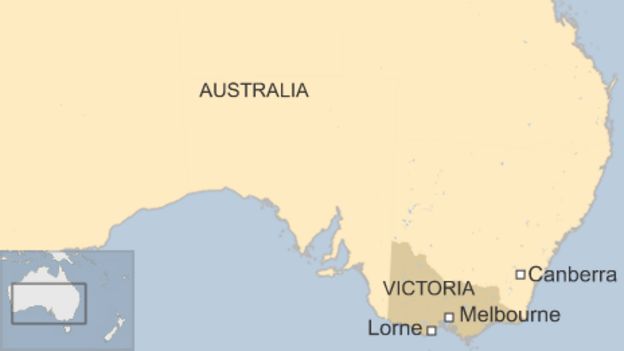
The blaze began with a lightning strike on 19 December and has been fanned by strong winds and intense heat in recent days, burning across 2,200 hectares (5,437 acres) so far.
Victoria is one of the most fire-prone regions in the world.
Many bushfires are started by lightning strikes, while others are sparked accidentally by campers or discarded cigarettes.
Some are the work of arsonists.
In 2009, more than 170 people died in Victoria during Australia's worst ever bushfire disaster.
27 DEC
Chinese mine owner kills himself as 17 miners remain trapped
The owner of a gypsum mine in China's eastern Shandong province has killed himself, as rescuers try to reach 17 miners who have been trapped for two days, state media report.
One person died and four miners escaped when the mine collapsed on Friday.
Since then, rescue workers have managed to pull a number of miners to safety.
China has a long history of industrial accidents. The latest incident comes days after a deadly landslide caused by construction waste in southern China.
Ma Congbo, the chairman of Yurong company which owns the mine, drowned himself by jumping into a mine well early on Sunday, China's Xinhua news agency reports.
His motive is not clear but the Chinese authorities have toughened the punishment of employers who are negligent, says the BBC's Stephen Evans in Beijing.
Mr Ma killed himself two days after the mine collapsed in Pingyi County's Linyi city, Shandong Province, just before 20:00 local time. It is not yet clear what caused the collapse.
Rescuers have drilled a hole to access some of the trapped workers, and are trying to transfer food and water, officials say. More than 700 emergency officials are involved in rescue efforts, according to Linyi Mayor Zhang Shuping.
Xinhua news agency reports that seven people have been rescued so far.
The facility was used to mine gypsum, a soft mineral that is widely used in construction.
The latest incident comes a week after a landslide in the southern city of Shenzhen killed one person and left another 75 people missing, presumed dead.
Authorities say the landslide was caused when a huge man-made mound of earth and construction debris lost stability and collapsed.
It is one in a series of industrial accidents to occur this year, with questions raised about rapid industrialisation and safety standards in China.
This tightening of safety law in recent years is credited with bringing a fall in the number of deaths of miners at work from 7,000 a year in 2002 to 931 last year, our correspondent says.
28 DEC
UK floods: Storm Frank threatens more misery
A fresh storm threatens to bring more misery to parts of the UK, including areas already hit by severe flooding.
Storm Frank is due to sweep in from Tuesday evening, with Cumbria and south and central Scotland most at risk.
There are four severe flood warnings - meaning "danger to life" - in force in England and Wales, along with 47 flood warnings requiring immediate action.
An old stone bridge in Tadcaster, North Yorkshire, has collapsed, and as a result a nearby gas pipe has ruptured.
The area around the bridge, over the River Wharfe, has been cleared. Shops and businesses in the main street of the small market town have been badly affected by flooding since the weekend, and the bridge had been closed for the past two days.
Twelve people have been evacuated from their properties as a result of the gas leak.
'Bad situation'
Meanwhile, Communities Secretary Greg Clark announced on Tuesday £50m extra funding to help households and businesses affected by flooding in northern England. The government says it has now pledged more than £100m towards the crisis.
The head of the Environment Agency, Sir Philip Dilley, is expected back in the UK by Wednesday, cutting short the Christmas holiday that he was spending at his property in Barbados.
Floods minister Rory Stewart told BBC Radio 4's Today programme residents should prepare for what could be "a very bad situation [on] Wednesday and Thursday".

'Troublemaker'
December has already seen communities in Cumbria, Lancashire, Greater Manchester and Yorkshire swamped by rising waters and Storm Frank now poses a new threat.
The number of severe flood warnings is now four - three at Croston in Lancashire, where an RAF Chinook helicopter has been delivering one-tonne sandbags in a bid to try to shore up the nearby River Douglas.
The fourth was issued in response to the collapse of the Tadcaster Bridge, where "significant flooding" is now expected.
The Met Office issued amber weather warnings - meaning "be prepared" - for rain in Strathclyde; Central, Tayside and Fife; Dumfries, Galloway, Lothian and Borders; Grampian; and north-west England for Wednesday.
There are also yellow weather warnings - meaning "be aware" - for rain for the rest of Scotland, Northern Ireland, Wales, north east England and Yorkshire and Humber.
At the scene - Jorvik Viking Centre, York
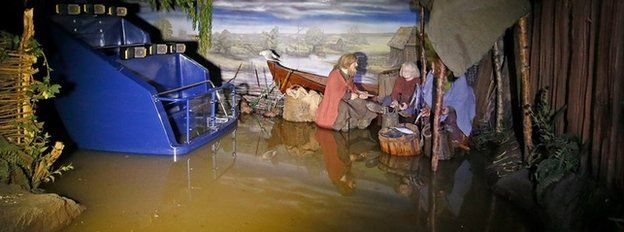 PA
PA
By Fiona Trott, BBC News, York
One place counting the cost is York's popular tourist attraction, the Jorvik Viking Centre.
"It's really hard to see it like this," the museum's director of attractions Sarah Maltby told us as we waded through the contaminated floodwater that has closed it.
The faces of the Viking dummies looked strange in the torchlight, and it felt warm and damp. Sarah explained how they saved some of their priceless exhibits by ripping a door off its hinges and using it as a flood barrier.
"Within about six hours we moved all our most valuable items - an original Viking sock, bowls and tools all dating back to the 9th Century."
The museum attracts 400,000 visitors a year and they don't yet know when it will reopen. It's just one corner of this historic city that's now counting the cost.
BBC weather presenter Sarah Keith-Lucas said: "The wind and the rain will strengthen during the course of Tuesday, all down to Storm Frank.
"That's going to be pushing towards the north of the UK but Tuesday night into Wednesday a trailing weather front will be quite a troublemaker, bringing not only destructive winds but also further heavy rain.
The Scottish Environment Protection Agency warned Storm Frank could bring further flooding to Scotland. Wales is also bracing itself for more rain.
Further afield, Ireland has also issued weather warnings ahead of the arrival of Storm Frank - two orange (equivalent to amber) and two yellow, both for wind and rain.
In York, BBC correspondent Jeremy Cooke says there is a bleak outlook for many, with some facing the loss of their livelihoods and others worried about claiming for the flood damage amid fears insurance companies will not insure them again.
Meanwhile, West Yorkshire Police warned residents that there had been incidents of theft of property left out to dry and said motorcycle clubs had offered to assist police in patrolling flood-hit areas "as extra eyes and ears on the ground".
'Lot of money'
The floods minister said £2.3bn being spent on flood defences over six years would allow the government to take long-term decisions.
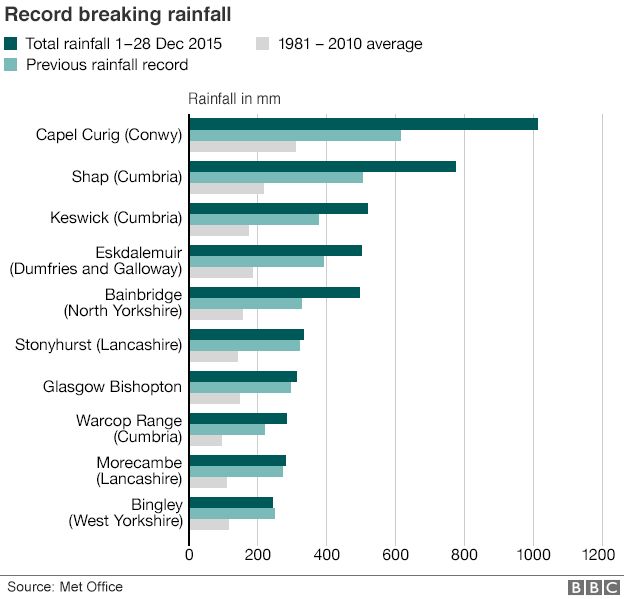
"We have to try to be fair, we're putting a lot of money into this and we're making sure we're spending it in the most cost effective way we can," Mr Stewart said.
The government has ordered a major review of flood prevention strategy.
Shadow chancellor John McDonnell told Today that the issue of flooding should be beyond party politics and any review must include the input of experts on the ground.
Lib Dem leader Tim Farron said extra funding was needed for flood defences and said David Cameron needed to "show he cares about the North by following up his words with deeds".
29 DEC
Battle of the sexes: 'Radical' laws reach 40th birthday
When the equal pay and sex discrimination acts were implemented in the UK, both were hailed as radical new legislation that would alter women's pay and workplace status. Forty years later, BBC News looks at what it was like to be a working woman in 1975 and how things have changed.
"For thousands of years man has regarded woman as a thing apart. A remote, mysterious, contrary, unpredictable goddess and bitch.
"However man has regarded woman until now, it has rarely been as equal."
Such were the words spoken on the 29 December 1975 by the BBC's Ludovic Kennedy, on the day the equal pay and sex discrimination acts came into force.
Passed in parliament separately but enforced on the same day, the acts were described as "radical legislation" whose impact was "far-reaching."
They would later be superseded by the Equality Act 2010, but the acts stood for 35 years and outlawed discrimination on pay between men and women, ruled job adverts had to be open to both, and bias by landlords, schools and finance companies became illegal.
'Second-class citizens'
On the day the laws came in to force, Gwen Davis remembers feeling "very pleased" but also aware that "not everybody would get equal pay".
Seven years earlier, she had taken part in the strikes that helped usher the Equal Pay Act through parliament in 1970, although it would be five more years before it was implemented.
In 1968 along with 186 female car-seat machinists, Mrs Davis downed tools at Ford's Dagenham factory and walked out demanding she and her colleagues be classed as skilled workers and paid equally.
"Why should we be classed as unskilled with the janitors and toilet cleaners? You couldn't be younger than 21 to get a job as a machinist at Ford, and you had to have two years machining experience," she recalls.
The strike - dramatised in the film Made in Dagenham in 2010 - lasted for three weeks, and secretary of state at the time Barbara Castle stepped in on the women's behalf.
Being a working woman at the time you were, Mrs Davis says, often made to feel like "a second-class citizen".
"There were lots of jobs advertised where women weren't accepted because they were seen as too incapable or weak, and when me and my husband went to get a mortgage for our house they didn't even consider women's earnings. Women's money was just seen as pin money," she said.
After three weeks of striking, the Ford workers agreed to go back to work on 92% (up from 87%) of the men's wages, but "still not the recognition as skilled workers", says Mrs Davis.
'You're in my seat'
Fast forward more than a decade to the early 1980s and women workers at Ford Dagenham were "still getting annoyed" at the lack of equality they had with their male colleagues, says 77-year-old former Ford Dagenham worker Dora Challingsworth.
She began working at Ford Dagenham in 1971, but does not remember the acts coming in to force in 1975 as "women were still downtrodden".
She recalls the time female workers were told by management they had to have a later lunch hour because male workers complained women took their seats in the canteen.
"Because we went to the canteen before the men, they would come up to us and say 'You're sitting in my seat'. I mean, crikey!
"Being a woman, you had to fight for everything."
That fight continued until, in 1984, women workers at the factory went on strike for a second time demanding again that their work be classed as skilled. After several weeks on the picket line they got what they wanted.
Despite that though, in the wider industry more than 30 years later the gender pay gap remains.
Hidden discrimination
According to the latest Office of National Statistics figures, the median pay gap between men and women's pay for full time workers was 9.4% in April 2015 - a slight decrease from 9.6% the year before, and at its lowest since figures were first recorded in 1997.
When pay of part-time workers is added however, the ONS median figure rises to 19.2%. In 2014, Trades Union Congress research showed that on average, for every pound earned by a man a woman was being paid 80p.
Sam Smethers, director of women's rights campaigning group Fawcett Society, says that while the pay gap is known the scale of discrimination in the work force remains unclear.
"There's a culture of secrecy around what your colleagues are earning and it's difficult to challenge or change that," she said.
Jacqueline O'Reilly, a professor at Brighton University, says she faced discrimination after getting her first lecturing job.
At the time two male colleagues with less experience than both she and another female member of staff, earned a salary three grades higher than theirs.
"When I asked what category was used to decide this, my employers couldn't explain," she told BBC News.
"I wouldn't have known about this other than I happened to be on the appointments panel and had to review references. In the end they paid what they thought they could get away with."
'Long way to go'
Maria Miller MP, chair of the women and equalities committee which is currently taking evidence on the gender pay gap, said while there has been huge progress made in the last four decades, there is still a long way to go.
"Many of the factors driving the gender pay gap are still baked in to the system, particularly the part-time working penalty women have to endure, which impairs their ability to progress in work and forfeits their chances of promotion and pay rises," she said.
"More than 40% of women choose to work part-time to fit around family responsibilities, and three quarters of part-time work is low paid. There has been progress in terms of the gender pay gap for women under 35, but we haven't seen this same progress for women over 40."
She adds that in order to stamp out the pay gap, there needs to be more women in leadership positions, greater access to training for women returning to work, and "greater transparency across the board".
New government legislation will soon require companies in the UK with more than 250 staff to publish details of male and female pay.
Ms Smethers says while this greater transparency is needed, the government needs to ensure that alongside this there is "an action plan to address the pay gap".
According to Fawcett Society, at the current pace of progress it will take over 50 years to close the gender pay gap for full time workers.
"Based on the evidence seen to date there's a very strong suggestion that unless there is a sea-change in business attitude to part-time working we may never see the gender pay gap eliminated at all," adds Mrs Miller.
30 DEC
Cosby victim 'paralysed' by drugs during alleged assault
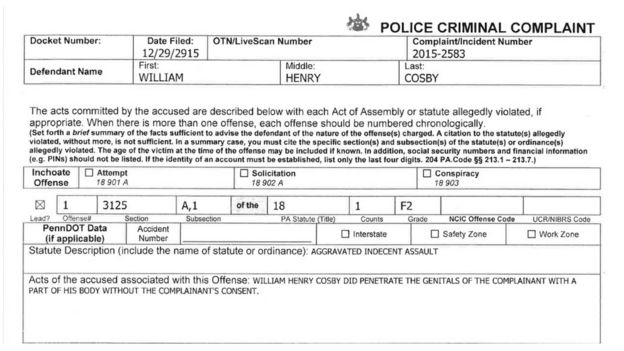
The criminal complaint against Bill Cosby details many unwanted advances from the comedian culminating in an incident where he is alleged to have drugged and then sexually assaulted a woman while she was unconscious.
The document sets out how Mr Cosby and Andrea Constand met on Temple University's campus in Philadelphia and became friends - the victim says she considered Mr Cosby a mentor.
According to the complaint, Mr Cosby tried to initiate sexual encounters with the victim on two occasions and she refused. The alleged assault occurred in early 2004 when the victim agreed to go to Mr Cosby's house to discuss her career and future.
She told him she was drained and he said he wanted her to relax.

Prosecutors allege that the victim protested when Mr Cosby offered her a glass of wine, saying she had not eaten that day.
He urged her to drink wine anyway, the victim says in her testimony, so she drank a few sips along with the pills.
Within 30 minutes, she says she experienced blurred vision and had trouble speaking. Mr Cosby then told her to lie down on the couch and relax.
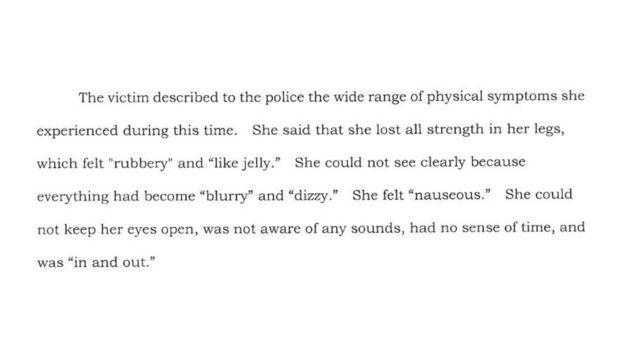
During that time she was lying on the couch, she says she was aware of Mr Cosby moving toward her, touching her breasts and genitals, and making her touch his genitals.
She says she did not consent to any of the acts, that she could not speak, and that she felt "frozen" and "paralysed".
She awoke in the middle of the night still inside Mr Cosby's home.

The criminal complaint outlines how the victim - and her family - challenged Mr Cosby over the alleged assault and how he came to provide his own version of events.
In his testimony to police, Mr Cosby admits that she came over that night and that he gave her pills to relax. He says they were Benadryl.
He admits there was a sexual encounter, but describes the acts as consensual.
And he tells police their relationship prior to the assault could be characterised as both social and romantic.
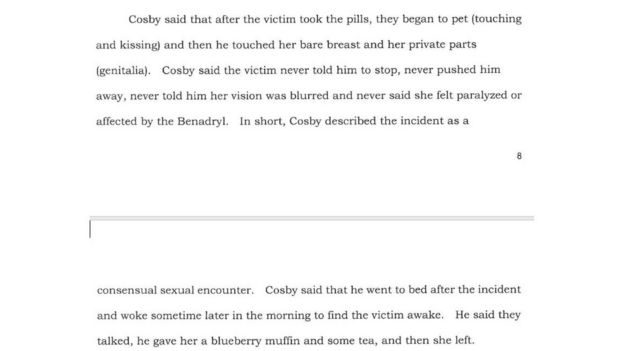
Prosecutors argue that Mr Cosby knowingly drugged the victim, seeking to render her defenceless.
They note in the complaint that he has never identified what the pills were. And they point out that in his testimony he admitted to using Quaaludes on other women.
Explaining why they are bringing the charge, they conclude:
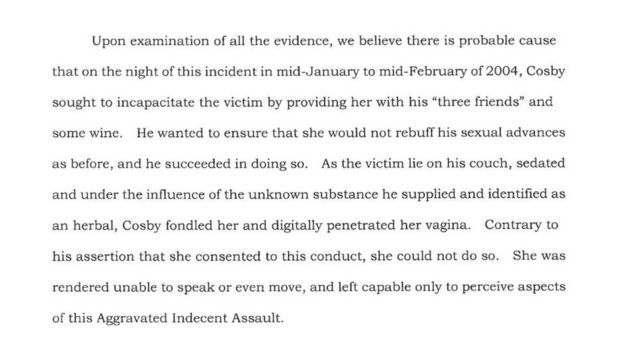
source : http://www.bbc.com/news/35195522
31 DEC
Turbulence on Air Canada flight from China injures 21
severe turbulence injured 21 passengers, including three children, officials said.
The Air Canada flight from Shanghai to Toronto was diverted to Calgary after the turbulence hit.
Eight passengers suffered neck and back injuries and 13 more were taken to hospital for observation.
The injured were in a stable condition, an emergency services spokesman said.
Bing Feng, a passenger, described hearing "lots of screaming" as the plane became "like a rollercoaster".
Another passenger, Yi Lee, said: "To start with it was just OK, normal just up and down, and all of a sudden it was really violent and just shaking everybody.
Analysis: Richard Westcott, transport correspondent, BBC News
Even enthusiastic fliers like me can get nervous when there is some chunky turbulence around. But although people can get hurt if they aren't strapped in, turbulence doesn't crash airplanes.
Lots of things can cause turbulence, but pilots can often predict when it's coming, so they can either avoid it or put on the fasten seat-belt signs. And aircraft are built to withstand even the worst excesses of mother nature. Wings are bent until they snap, hulls are tested by attacking them with artificial lightning strikes. In the most extreme examples, turbulence could potentially damage an aircraft, but it won't knock it out of the sky.
There is a brilliant blog about it here. It points out that most of the small number of injuries each year are to flight crews. It also says that the best place to sit if you hate turbulence is over the wings - and the worst place is at the back.
"Suddenly the flight is just going down and everything is really scary. The girl sitting next to me, she was sleeping and she just fly up [to the ceiling]."
Gord Murray, a frequent flyer, said the turbulence was the worst he'd ever experienced.
Some passengers were taken off the plane strapped to stretchers. Emergency Medical Services spokesman Stuart Brideaux said the injuries were limited to non-life-threatening neck and back injuries.
Air Canada's chief operating officer Klaus Goersch said the passengers had been through a "very unsettling experience".
He praised the crew's response and said some of the injured had been quickly discharged.
The Boeing 777 with 332 passengers and 19 crew on board landed at Calgary without further incident, the airline said in a statement.



